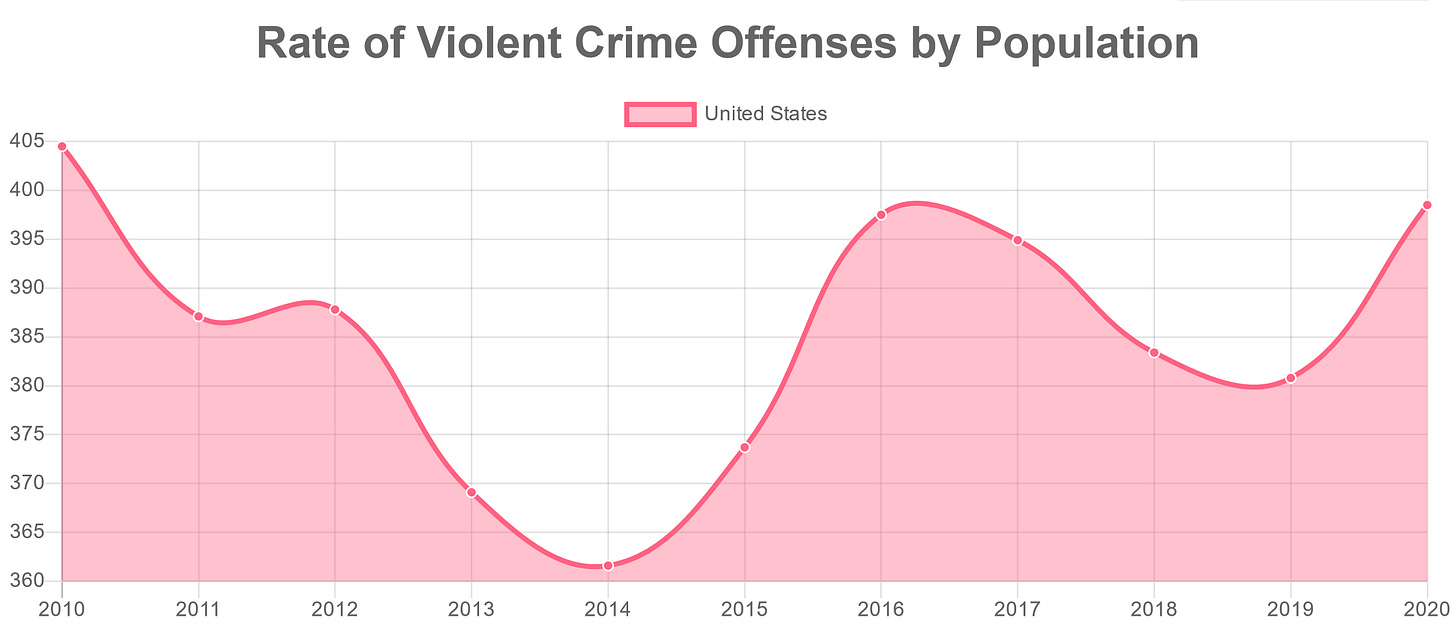We aren't in a crime wave. Until we are.
While it might still be too early to establish a trend, if this is what preliminary data shows, don’t expect Hechinger’s argument to hold up a year from now.
Scott Hechinger, a Los Angeles-based civil rights attorney, has a lengthy thread in which he argues there exists no “crime wave” and this is largely a media-manufactured panic:


Back in September, I argued in American Greatness that America wasn’t in the grip of a crime wave, but that concerns regarding crime weren’t anything to scoff at, either. I stand by that argument, as I believe it to be validated by data, the same data Hechinger believes validates his belief that crime isn’t a problem.
He repeatedly points out that crime is still overall down from historic highs:






Hechinger repeats the phrase “the only crime rate increased last year” in three successive tweets, likely to ingrain in a reader’s head that violent crime increased only in a single category. But is that true?
Take a look at the latest FBI crime statistics. These charts are all available here:
Hechinger is most certainly correct: though crime clearly increased in 2020, we’re still nowhere near the jaw-dropped highs of the early 1990s. However, let’s take a look at the rates of homicides, aggravated assaults, arson, and motor vehicle theft in 2020:
Sure seems like the crime rate increased in more than one category, didn’t it? Granted, the most dramatic shifts occurred with homicides and, possibly, aggravated assaults, but these are also the most dangerous types of crimes to begin with. They also tend to be the category of crime people are least likely to become a victim of, which certainly comes as reassurance.
But let’s go back to this tweet by Hechinger. Notice he says homicides are “declining again:”

What’s he basing this assertion off of? According to one data set, homicides are currently at +7% year-over-year. Not a “spike,” perhaps, but a rather clear and obvious uptick. While it might still be too early to establish a trend (we’ll need to wait at least another year for 2021 stats to be published), if this is what preliminary data shows, don’t expect Hechinger’s argument to hold up a year or two from now.
On the topic of data, which Hechinger professes to swear by, let’s take look at the the longer term trend again. This time, let’s look at the 20-year trend for violent crime nationally, to avoid major outliers in the data:
Even on a 20-year scale, crime is still much lower today than before. 2014 was, evidently, the most peaceful year ever and is where I want to bring your attention to. Between 2014 and 2020, the violent crime rate increased in this country from 361.6 per capita to just shy of 400. Again, this isn’t the biggest jump in the world, but, after striking such a dramatic low in 2014, the trend immediately reversed itself. After a three-year decline from 2016 to 2019, violent crime is now back on an upward trend.
How pronounced was this “bounce?” Look at it just from the perspective of the 2010s. If anything, the trough of 2014 seems to be the data outlier, not 2020:
Again, a rather clear and obvious upward trend.
I point this out to show that the “historic low” of violent crime has probably already passed. It was the end of a trend that began 25 years earlier and, the law of averages states it was bound to reverse itself, eventually. But, even I didn’t realize how dramatically it reversed itself until I began to look at the data from different perspectives.
It’s possible the trend could shift downward again. However, I doubt it happened in 2021, at least based on preliminary data. Furthermore, when looking further back in history, there were years where violent crime did trend downward, only to pick back up a few years later, adding to the overall upward trajectory:
Notice the two major drop-offs in the 1970s and early-to-mid-1980s. I show this to demonstrate that trends are, in fact, fickle things. Just as it seemed crime was declining, it suddenly shot up again, getting worse with each spike. If Hechinger won’t put stock into a one- or two-year trend, perhaps he’ll put more stock into a six-year trend that shows a clear uptick in violent crime?
Finally, arguing that crime is at historic lows begs the question: at what point do we become concerned with crime? Should we wait until things get as bad as they were in the early 1990s? Who gets to control the narrative here? And, given that we do live in a more crime-free society than we did 30 years ago, doesn’t that actually make it more concerning that we’re seeing rather quick increase after hitting such incredible lows six years ago?
History is, after all, a tale of slow burns.
Max Remington writes about armed conflict and prepping. Follow him on Twitter at @AgentMax90.
If you liked this post from We're Not At the End, But You Can See It From Here, why not share? If you’re a first-time visitor, please consider subscribing!









